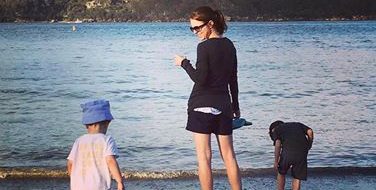 Sitting in my doctor’s office, I tried not to stare out the windows, where the east- and westbound lanes of I-285 rushed by. The whirring cars just made me nervous, but then again…everything makes me nervous. That was kind of why I was here. Well, that and the yearly mandate that comes with being female.
Sitting in my doctor’s office, I tried not to stare out the windows, where the east- and westbound lanes of I-285 rushed by. The whirring cars just made me nervous, but then again…everything makes me nervous. That was kind of why I was here. Well, that and the yearly mandate that comes with being female.
I had sat in this chair so many times before: during pregnancies, while trying to get pregnant, after a scary mammogram, and during a miscarriage. Most recently, I sat here and told him that I needed something extra, a little help. I left with a prescription for Xanax in hand. Today, eight months after that visit, the bottle still holds a few pills–little white tablets whose primary purpose of late has been unwinding my anxiety at night and helping me sleep.
On this day, though, from this chair, I asked him what the hell was going on with my hormones and if it was normal for them to be fluctuating way the eff all over the place. I may have phrased it differently. But I’ve been all over the map lately–literally, and emotionally–and I wondered if it were more than circumstantial. If it might also be chemical. The short answer? Yes. He referenced a drug that several friends have also mentioned–one that has helped them feel more like themselves. I thought that sounded good, since I’ve hard a hard time remembering who I am lately in these throes of moving and marriage and motherhood, and the resistance I’ve been halfheartedly building within my mind–composed of “just wait and see”s and “maybe it will get better on its own”s–they crumbled under the added pressure of medical reasoning. I took the script, got it filled, and swallowed the first one an hour later.
My counselor had taught me a technique awhile back to deal with anxiety, a strategy pioneered by a doctor in Australia (!) that tosses around terms like mindfulness that make me feel the urge to grab a yoga mat and some green tea but really just involve perspective; specifically, stepping outside myself and observing what happens to me when I get all wound up. I said I’d try it, doubting it would work, and as has happened once or twice before, I was wrong. Looking at myself from a new vantage point allowed me to see how much of me is still the little girl who’s afraid of failing. Afraid of looking like an idiot. Afraid of being hurt. Now, though, those fears have the added pressure of a family riding on them. No wonder I often have trouble breathing–I’ve been trying to hold all that up myself.
The day The Husband left for his most recent trip to Sydney, I was pulling out of the garage with the boys in the backseat waving goodbye. I had my eye on TH, trying not to hit him because I was in a charitable mood, and didn’t notice that my left side was inching closer to the garage door until my mirror slammed into it. I should mention that this is far from the first time this exact event has occurred: I’m looking at one thing while another gets butchered. Better car than husband? Anyway, TH secured the mirror with duct tape and we parted ways for a week, The Kid in the backseat narrating what had happened: “Mommy hit her mirror on the garage,” the refrain echoing over and over from the backseat. I tried to remember how I used to have to narrate everything for him. You know, #gratitude. He’s been giving me countless opportunities since then to call upon that memory as my mirror still sits encased in duct tape, evidence of my constant inability to see all things at once.
And it’s funny, because I’ve always told TK that I love how his brain works even as I’ve struggled to understand it, and I read recently about how some people on the spectrum (and, let’s be honest, probably a lot of others as well) have trouble with a thing in the brain called mirror neurons that interpret facial cues and incorporate them into appropriate reciprocal behavior. This results in a type of social blindness, or at least social visual impairment, because the person is focused elsewhere. This, along with sensory overload, can contribute to a lack of eye contact. I’ve read such information with reactions that fluctuate way the eff all over the place depending on my “self” at the moment, but the thing I keep coming back to is how quick the world is to call such differing perspective a disability. I’m looking at the wrong thing all the time, after all. Meanwhile, I’m not sure TK is, like, ever.
My car is, like me, a bit beat up and held together. My phone is, like me, a bit cracked, and the camera only works in selfie mode, forcing me to change the way I take every picture. Forcing me to take less of them and, instead, just look ahead. My children, though, are looking at each other and laughing. They are tubing down fake snow-covered hills and jumping around bounce houses and taking chances and believing in a way they don’t even realize that they are taken care of. And on Saturdays, TK and I go to the indoor pool that serves as swimming lesson location on one side, senior citizen exercise center on the other, and the man swimming laps gets a big grin from TK. Later, while TK paddles with his instructor, the man walks by me. “You have a wonderful boy,” he says. A minute later, the woman who teaches water aerobics passes between me on one side, TK in the pool on the other, and smiles at me. “Beautiful,” she says. I think about all the ways grace is working, all the things it is using to make me who I’m meant to be, this fluctuating mixture of prayer and people and pills. I think about all the moments I’ve caught TK staring at something I couldn’t see with a delighted grin on his face. About all the things I read telling me what he can’t see, and all the more that he’s showing me he can.
